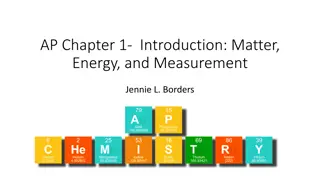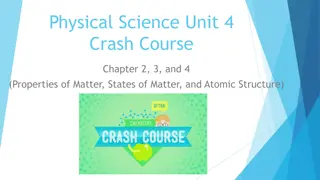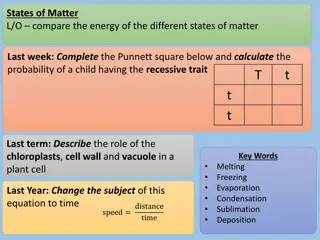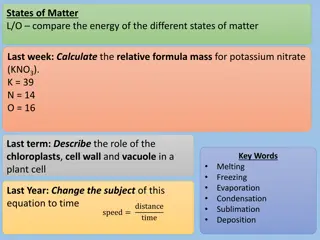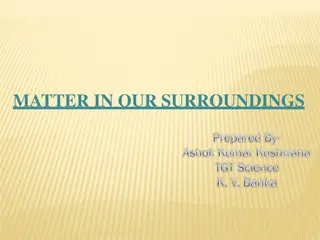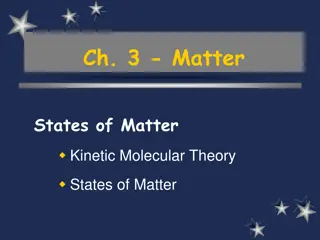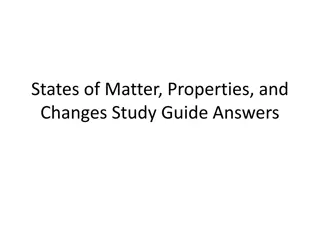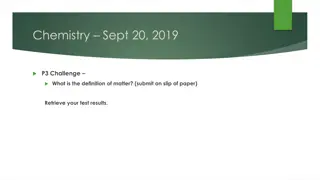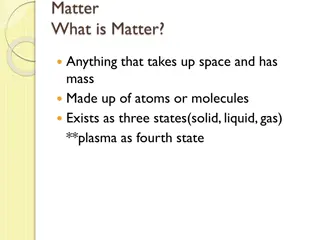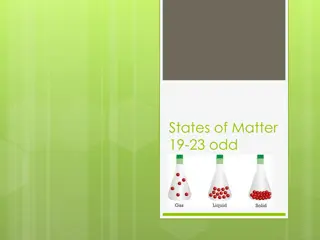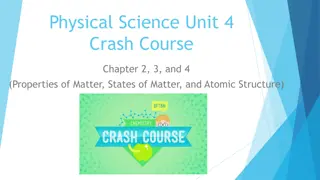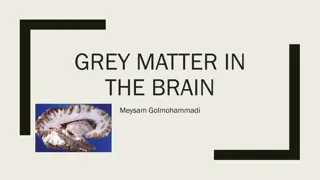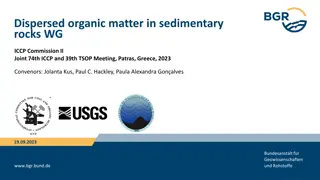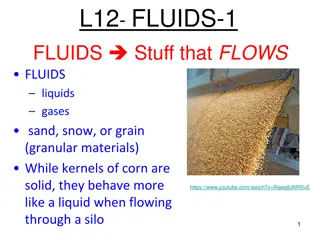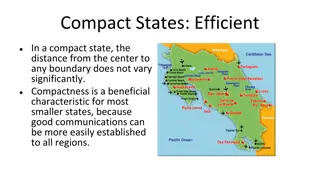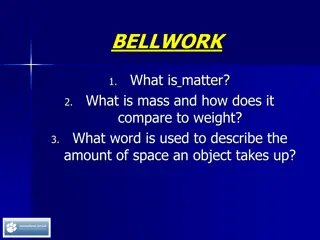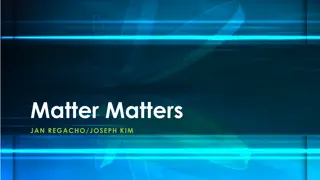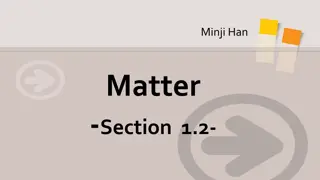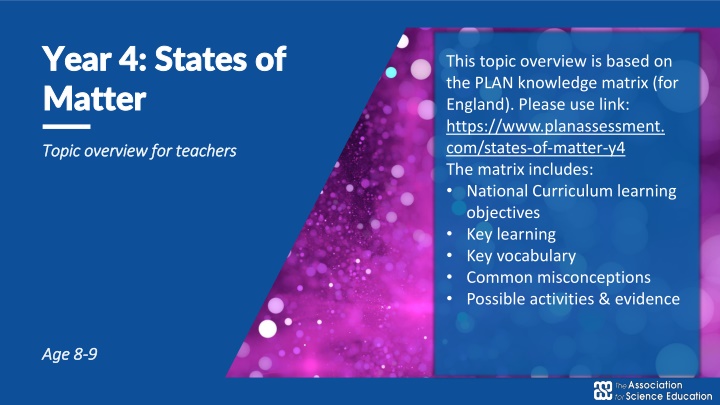
Exploring States of Matter in Year 4
This topic overview delves into the states of matter - solid, liquid, and gas - for Year 4 students based on the PLAN knowledge matrix for England. It covers the key learning objectives, vocabulary, common misconceptions, and possible activities to help teachers introduce concepts like melting, boiling, evaporation, and the water cycle. The content includes engaging activities and resources to facilitate a comprehensive understanding of solids, liquids, and gases.
Download Presentation

Please find below an Image/Link to download the presentation.
The content on the website is provided AS IS for your information and personal use only. It may not be sold, licensed, or shared on other websites without obtaining consent from the author. If you encounter any issues during the download, it is possible that the publisher has removed the file from their server.
You are allowed to download the files provided on this website for personal or commercial use, subject to the condition that they are used lawfully. All files are the property of their respective owners.
The content on the website is provided AS IS for your information and personal use only. It may not be sold, licensed, or shared on other websites without obtaining consent from the author.
E N D
Presentation Transcript
Year 4: States of Year 4: States of Matter Matter This topic overview is based on the PLAN knowledge matrix (for England). Please use link: https://www.planassessment. com/states-of-matter-y4 The matrix includes: National Curriculum learning objectives Key learning Key vocabulary Common misconceptions Possible activities & evidence Topic overview for teachers Topic overview for teachers Age 8 Age 8- -9 9
Year 4 States of Matter Topic Key Learning There are three states of matter: solid, liquid and gas. A solidkeeps its shape and has a fixed volume. Some solids are made up of small grains which can be poured into a heap. A liquid has a fixed volume but changes in shape to fit the container. A liquid can be poured and keeps a level, horizontal surface. A gas fills all available space; it has no fixed shape or volume. page Introduction to solids, liquids and gases 4 A liquid has a fixed volume but changes in shape to fit the container. A liquid can be poured and keeps a level, horizontal surface. Someliquids flow less easily and are slow to pour. Exploring the properties of liquids 5 Melting is a change of state from solid to liquid. Freezing is a change of state from liquid to solid. The temperature a liquid freezes at is called its freezing point. The freezing point of water is 0oC. Different substances have different freezing points. Changes of state: investigating freezing and melting 6 2
Year 4 States of Matter Topic Key Learning Boiling and evaporation are both a change of state from liquid to gas. Boiling happens at a specific temperature and bubbles of the gas can be seen inside the liquid. Water boils when it is heated to 100oC. Evaporation happens at any temperature and only at the surface of the liquid. It happens more quickly if the temperature is higher, the liquid has a larger surface area or it is windy. page Changes of state: comparing boiling and evaporation 7 The water cycle is an example of evaporation and condensation. Water at the surface of seas, lakes and rivers evaporates into water vapour, a gas. Water vapour rises and cools. It condenses back into liquid water droplets which form clouds. When the water droplets in a cloud get too heavy, they fall as rain, sleet or snow. This is known as precipitation. Understanding evaporation, condensation and the water cycle 8 A gas fills all available space; it has no fixed shape or volume. Many gases are invisible. A gas has a mass, so its weight can be measured. A gas can be squashed or compressed into a smaller space. Exploring the properties of gases 9 3
States of matter States of matter Introduction to solids, liquids and gases Introduction to solids, liquids and gases Activities and websites Exploring prior knowledge about solids and liquids. Key Learning There are three states of matter: solid, liquid and gas. A solidkeeps its shape and has a fixed volume. Some solids are made up of small grains which can be poured into a heap. https://www.bbc.co.uk/bitesize/clips/zv4rkqt Comparing the properties of solids, liquids and gases. A gas fills all available space; it has no fixed shape or volume. https://www.bbc.co.uk/bitesize/clips/zrdkjxs A liquid has a fixed volume but changes in shape to fit the container. A liquid can be poured and keeps a level, horizontal surface. https://www.bbc.co.uk/bitesize/topics/zkgg87h/articl es/zsgwwxs Classifying a range of objects as solids, liquids or gases using a Venn diagram. I can Additional activity to explore solids, liquids and gases in fruits and vegetables. https://pstt.org.uk/application/files/1115/8694/0466/4._SINK_OR_SWIM.pdf classify a range of objects and materials as solids, liquids or gases. 4
States of matter States of matter Exploring the properties of liquids Exploring the properties of liquids Activities and websites Exploring the properties of liquids. Investigating the thickness of different liquids. Key Learning A liquid has a fixed volume but changes in shape to fit the container. A liquid can be poured and keeps a level, horizontal surface. https://www.youtube.com/watch?time_continue=1& v=m3dzLaZKmDE&feature=emb_logo Additional optional activities to find out more about floating and sinking in different liquids. Someliquids flow less easily and are slow to pour. https://pstt.org.uk/application/files/6115/8633/7142 /3._EGG-CITING_SCIENCE.pdf I can describe the properties of liquids. compare the thickness of different liquids. https://www.youtube.com/watch?time_continue=30 &v=QwCgPkPrA-A&feature=emb_logo 5
States of matter States of matter Changes of state: investigating freezing and melting Changes of state: investigating freezing and melting Activities and websites Exploring prior knowledge about melting and freezing. Key Learning Melting is a change of state from solid to liquid. Freezing is a change of state from liquid to solid. The temperature a liquid freezes at is called its freezing point. The freezing point of water is 0oC. Different substances have different freezing points. https://www.bbc.co.uk/bitesize/topics/zkgg87h/articl es/z9ck9qt Observing how different liquids freeze and melt. https://pstt.org.uk/application/files/9315/8513/5527 /1._Science_with_Ice.pdf Optional further activity investigating melting. Optional activity to find out more about melting different types of chocolate. I can compare ice and other frozen liquids. observe how different solids melt. https://www.youtube.com/watch?v=OnE_84GtPdU&list=PL g7f-TkW11iV563gfcXjRlafm2jlklQOc&index=12&t=0s https://www.youtube.com/watch?v=CA2d_b8E6Ds 6
States of matter States of matter Changes of state: comparing boiling and evaporation Changes of state: comparing boiling and evaporation Activities and websites: Exploring prior knowledge about boiling and evaporation. Understanding the difference between boiling and evaporation. Key Learning Boiling and evaporation are both a change of state from liquid to gas. Boiling happens at a specific temperature and bubbles of the gas can be seen inside the liquid. Water boils when it is heated to 100oC. Evaporation happens at any temperature and only at the surface of the liquid. It happens more quickly if the temperature is higher, the liquid has a larger surface area or it is windy. https://www.bbc.co.uk/bitesize/clips/z9d9wmn Investigating how quickly water evaporates with a comparative test. Optional activity to design another investigation to explore how quickly water evaporates. I can compare boiling and evaporation. investigate how quickly water evaporates from different sized containers. 7
States of matter States of matter Understanding evaporation, condensation and the water cycle Understanding evaporation, condensation and the water cycle Key Learning The water cycle is an example of evaporation and condensation. Water at the surface of seas, lakes and rivers evaporates into water vapour, a gas. Water vapour rises and cools. It condenses back into liquid water droplets which form clouds. When the water droplets in a cloud get too heavy, they fall as rain, sleet or snow. This is known as precipitation. Activities and websites: Exploring prior knowledge on condensation. Understanding how water evaporates and condenses. https://www.bbc.co.uk/bitesize/topics/zkgg87h/articl es/zydxmnb Investigating and modelling the water cycle. https://www.bbc.co.uk/bitesize/topics/zkgg87h /articles/z3wpp39 https://www.bbc.co.uk/bitesize/clips/zh4rkqt Optional activity to describe the journey of a water droplet in the water cycle. I can make a model of the water cycle. evaluate how well the model shows evaporation, condensation and precipitation. https://www.dkfindout.com/uk/earth/water-cycle/ 8
States of matter States of matter Exploring the properties of gases Exploring the properties of gases Key Learning A gas fills all available space; it has no fixed shape or volume. Many gases are invisible. A gas has a mass, so its weight can be measured. A gas can be squashed or compressed into a smaller space. Activities and websites Does air weigh anything? Comparing air, helium and carbon dioxide. https://www.bbc.co.uk/bitesize/clips/zhbygk7 Understanding that gases can be compressed. https://www.bbc.co.uk/programmes/articles/41CtKN ScD66yfvn37tPzmNP/studying-tool-using-tusk-fish Describing some everyday uses of gases. Optional activities making carbon dioxide gas. I can understand the properties of gases. describe some everyday uses of gases. https://pstt.org.uk/application/files/8615/8814/8781 /Science_Fun_at_Home_6_Gases.pdf https://bit.ly/3avocm1 9

